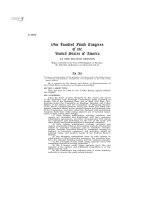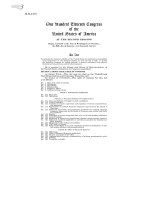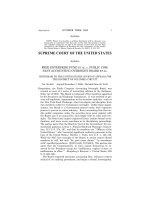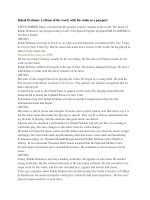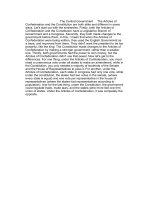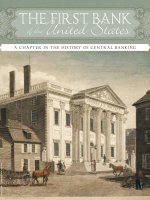3 2 3 a citizen of the united states
Bạn đang xem bản rút gọn của tài liệu. Xem và tải ngay bản đầy đủ của tài liệu tại đây (3.18 MB, 10 trang )
Fascinating Facts
• Between 2001 and 2003, 1.4 million
immigrants became United States citizens.
• During the week of July 4, 2003, 9,500 new
citizens were sworn in.
• Most of the new citizens in this country
now come from Mexico, Vietnam, and
the Philippines.
Genre
Nonfiction
Comprehension Skill
Compare and
Contrast
Text Features
•
•
•
•
Glossary
Chart
Headings
Table of Contents
Scott Foresman Social Studies
ISBN 0-328-14827-X
ì<(sk$m)=beichb< +^-Ä-U-Ä-U
The word citizen can have many different
meanings. In this book you will explore different
types of citizenship, how someone becomes a
citizen, and what the rights and responsibilities of
citizenship are.
Vocabulary
citizen
immigrant
opportunity
custom
Write to It!
Is there something in your community that
good citizens could make better? Write
three paragraphs about what the problem
is and how it could be fixed.
Write your paragraphs on a separate sheet
of paper.
community
recycle
natural resource
Table of Contents
Being a Citizen . . . . . . . . . . . . . . . . . . . . . . . . . page 2
What Makes You a United States Citizen? . . . page 3
Responsibilities Go with Rights . . . . . . . . . . . page 6
Everyone Can Be a Good Citizen . . . . . . . . . . page 9
Improving Your Community . . . . . . . . . . . . . page 11
Making a Difference . . . . . . . . . . . . . . . . . . . . page 14
ISBN: 0-328-14827-X
Copyright © Pearson Education, Inc. All Rights Reserved. Printed in the
United States of America. This publication or parts thereof may be used with appropriate
equipment to reproduce copies for classroom use only.
1 2 3 4 5 6 7 8 9 10 V0G1 14 13 12 11 10 09 08 07 06 05
Photographs
Every effort has been made to secure permission and provide appropriate credit for photographic material. The publisher deeply
regrets any omission and pledges to correct errors called to its attention in subsequent editions.
Unless otherwise acknowledged, all photographs are the property of Scott Foresman, a division of Pearson Education.
Photo locators denoted as follows: Top (T), Center (C), Bottom (B), Left (L), Right (R) Background (Bkgd)
Opener: ©Peter Bennett/Ambient Images, Inc.
2 ©Elyse Lewin/Getty Images
3 ©Mark Richards/Corbis
5 ©AP/Wide World Photos
6 ©Will & Deni McIntyre/Corbis
Editorial Offices: Glenview, Illinois • Parsippany, New Jersey • New York, New York
7 ©Myrleen Ferguson Cate/PhotoEdit
8 ©Getty Images
Sales Offices: Needham, Massachusetts • Duluth, Georgia • Glenview, Illinois
9 ©Tom Carter/PhotoEdit
Coppell, Texas • Ontario, California • Mesa, Arizona
10 ©Michael Newman/PhotoEdit
11 ©Maggie Murray/Alamy Images
12 ©Getty Images
13 ©Digital Vision Ltd./SuperStock
14 ©Myrleen Ferguson Cate/PhotoEdit
15 ©Nik Wheeler/Corbis
1. Being a Citizen
“He is a United States citizen.” “Be a good
citizen.” Compare these two statements. Ask
yourself if the word citizen means the same thing in
each sentence.
The word citizen has different meanings. In
the first sentence, the word has a legal meaning.
A United States citizen is a citizen by law. In the
second sentence it has a social meaning. Here,
citizen means “a member of a group.” As you read
this book, you will learn more about each meaning.
2. What Makes You a United
States Citizen?
There are three ways to become a United States
citizen. One way is to be born in the United States.
You can also be born to parents who are United
States citizens. In this case where you are born is
not important. As long as one of your parents is a
citizen of the United States, you are also a citizen.
The third way is to study to become a citizen.
Many of the thousands of immigrants who come
here each year do just that. They learn about the
history of the United States. They learn about how
the government works. They also learn about the
rights shared by citizens of the United States.
2
3
Some immigrants come here with the plan of
staying a short time and then going home. They
stay as long as needed to go to school or to work.
A large number of immigrants, however, want the
opportunity to become citizens with the rights that
only citizens have. They want the right to vote and
even to run for office. These people can become
naturalized citizens by meeting the requirements
on the chart below.
These are some requirements for becoming a
naturalized citizen.
4
To become United States citizens, immigrants
must take a written test. The one hundred
questions test knowledge of United States history
and government.
Stories from our history help people understand
us. They show how we got our rights and freedoms.
Learning about the past shows what is important.
Knowing about our government is helpful. To
fully participate in the government, citizens need to
understand how our government works and how it
protects our freedoms. Citizens also need to know
certain customs of this country.
5
3. Responsibilities Go with Rights
Our country guarantees many rights to its
citizens. We are free to say or write what we think.
We have the right to know what our government is
doing. Each of us has the right to be treated fairly.
Our government also provides many of the
services we need. It runs schools, libraries, parks,
and police and fire stations. It manages our mail
service and provides us with clean water.
One of our major rights is the right to choose our
leaders by voting. Once a citizen is eighteen years
old, he or she has the right to vote.
With the right to vote comes the responsibility of
voting wisely. At election time we should read the
newspapers and watch TV carefully to learn about
our leaders. We should ask who will help make
laws that are good for the United States.
Another one of our responsibilities is paying
taxes to the government. You might pay taxes when
you buy something because a sales tax is added to
your bill. There are many different kinds of taxes.
The government uses tax money to provide services
to its citizens.
6
7
We have a responsibility to obey laws. Many laws
are made to protect us. Some laws make sure we
are treated fairly and help us live together. Other
laws protect our safety and health.
Traffic laws help prevent accidents. They tell us
how to ride or drive safely. Some health laws set
standards for how to prepare food and treat water
so that they are clean and safe.
Some laws make sure that our country will be a
good place to live. You must attend school so that
you will learn to read, write, and think clearly. This
will help you and your classmates become good
citizens and smart voters when you are adults. Some
of you may even become leaders in your community.
4. Everyone Can Be a Good Citizen
Think about the social meaning of citizen. It
means “someone who lives in a community.” When
people live close together, they are all citizens of
that community. With this meaning a citizen can
even be a visitor from another country.
A community has a lot to offer its citizens. Its
buses, shops, schools, and parks are there for
everyone to use. Trash may be picked up and
mail may be delivered. Snow and leaves may be
removed from a community’s streets. When you are
older, a community can provide work for you. Your
community takes care of many of your needs and
will continue to do so for your entire life.
8
9
5. Improving Your Community
To give back to the community, people try to be
good citizens. Being a good citizen is not hard if
you remember to think of others’ needs. Before you
act or speak, stop to think about the effect of your
actions or words on others.
You already know a number of ways to be a good
citizen.
• Treat other people fairly.
• Be polite.
• Share what you have.
• Take turns.
• Do not take or damage another’s property.
• Solve problems by talking.
10
If you are on a street where trash blows across
the sidewalk and fills the gutter, would you look
around and feel happy? Garbage is not a pretty
sight. Litter makes it look as if people do not care
about their community.
Keeping streets clean is one way
to be a good citizen and show
pride in your community.
It shows respect for
your neighbors.
Some
communities
have clean-up
days. People
work together to
throw away trash.
Buildings are
fixed and painted.
Flowers are
planted. Citizens
work together
to improve their
community.
11
We are all citizens of the world. We take pride in
how we care for Earth. We should think about the
effects of our actions years from now. We have a
responsibility to the people who will live after us.
We owe it to them to keep our air and water clean.
We can try to leave Earth better than it is.
You can do your part by riding your bike or
walking to where you want to go. Each time a car
gets on the road, it produces gases that dirty the air
and make it harder to breathe. Help keep our water
clean by not throwing trash into rivers and lakes.
Recycle as much as you can.
Good citizens are careful not to use up Earth’s
natural resources. A natural resource helps us
meet our needs. A resource is something such as
trees, oil, and minerals. Stop to think of some ways
we use each of these things. We do not have an
endless supply of them.
Each time you buy something new, you use up
the resources that went into making it. If fewer
people buy products, fewer products will be made.
Make trades or share with friends. Take good care
of what you own so you will not need to replace it.
12
13
6. Making a Difference
Good citizens can become volunteers to help
other people in their community. Volunteers work
without being paid.
You do not have to be an adult to be a volunteer.
You can cheer up older people in nursing homes or
help younger children with their homework. You
can pick up litter in a nearby park. In some towns
there are jobs at libraries for young people in the
summer. There are many ways for you to help in
your community!
Many of us have the same hopes for our lives. We
want to have our needs met and to live peacefully
and safely. We want to be treated fairly and enjoy
our freedom.
We can help these things happen by being good
citizens. This means being thoughtful of others and
living in an unselfish way.
Each time you make your community a bit better
through your actions, you make the world a bit
better too.
15
The word citizen can have many different
meanings. In this book you will explore different
types of citizenship, how someone becomes a
citizen, and what the rights and responsibilities of
Glossary
citizenship
are.
citizen a member of a community
community a place
where people live,
Vocabulary
work, and have fun
together
citizen
custom a way ofimmigrant
doing things
immigrant a person
who moves into a
opportunity
country to live there
custom
natural resource useful material that
community
comes from the
Earth
recycle
opportunity a chance
for something
Write to It!
Is there something in your community that
good citizens could make better? Write
three paragraphs about what the problem
is and how it could be fixed.
Write your paragraphs on a separate sheet
of paper.
natural resource
better to happen
recycle to use something again
Table of Contents
Being a Citizen . . . . . . . . . . . . . . . . . . . . . . . . . page 2
What Makes You a United States Citizen? . . . page 3
Responsibilities Go with Rights . . . . . . . . . . . page 6
Everyone Can Be a Good Citizen . . . . . . . . . . page 9
Improving Your Community . . . . . . . . . . . . . page 11
Making a Difference . . . . . . . . . . . . . . . . . . . . page 14
ISBN: 0-328-14827-X
Copyright © Pearson Education, Inc. All Rights Reserved. Printed in the
United States of America. This publication or parts thereof may be used with appropriate
equipment to reproduce copies for classroom use only.
1 2 3 4 5 6 7 8 9 10 V0G1 14 13 12 11 10 09 08 07 06 05
16
Photographs
Every effort has been made to secure permission and provide appropriate credit for photographic material. The publisher deeply
regrets any omission and pledges to correct errors called to its attention in subsequent editions.
Unless otherwise acknowledged, all photographs are the property of Scott Foresman, a division of Pearson Education.
Photo locators denoted as follows: Top (T), Center (C), Bottom (B), Left (L), Right (R) Background (Bkgd)
Opener: ©Peter Bennett/Ambient Images, Inc.
2 ©Elyse Lewin/Getty Images
3 ©Mark Richards/Corbis
5 ©AP/Wide World Photos
6 ©Will & Deni McIntyre/Corbis
7 ©Myrleen Ferguson Cate/PhotoEdit
8 ©Getty Images
9 ©Tom Carter/PhotoEdit
10 ©Michael Newman/PhotoEdit
11 ©Maggie Murray/Alamy Images
12 ©Getty Images
13 ©Digital Vision Ltd./SuperStock
14 ©Myrleen Ferguson Cate/PhotoEdit
15 ©Nik Wheeler/Corbis

